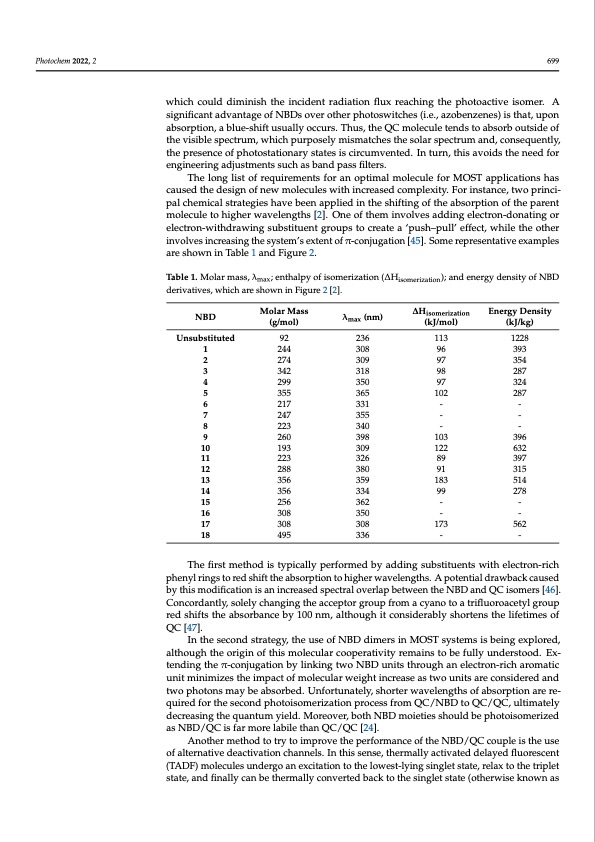
PDF Publication Title:
Text from PDF Page: 006
Photochem 2022, 2 699 which could diminish the incident radiation flux reaching the photoactive isomer. A significant advantage of NBDs over other photoswitches (i.e., azobenzenes) is that, upon absorption, a blue-shift usually occurs. Thus, the QC molecule tends to absorb outside of the visible spectrum, which purposely mismatches the solar spectrum and, consequently, the presence of photostationary states is circumvented. In turn, this avoids the need for engineering adjustments such as band pass filters. The long list of requirements for an optimal molecule for MOST applications has caused the design of new molecules with increased complexity. For instance, two princi- pal chemical strategies have been applied in the shifting of the absorption of the parent molecule to higher wavelengths [2]. One of them involves adding electron-donating or electron-withdrawing substituent groups to create a ‘push–pull’ effect, while the other involves increasing the system’s extent of π-conjugation [45]. Some representative examples are shown in Table 1 and Figure 2. Table 1. Molar mass, λmax; enthalpy of isomerization (∆Hisomerization); and energy density of NBD derivatives, which are shown in Figure 2 [2]. NBD Molar Mass (g/mol) λmax (nm) 236 308 309 318 350 365 331 355 340 398 309 326 380 359 334 362 350 308 336 ∆Hisomerization Energy Density (kJ/mol) (kJ/kg) 113 1228 96 393 97 354 98 287 97 324 102 287 - - - - - - 103 396 122 632 89 397 91 315 183 514 99 278 - - - - 173 562 - - 92 2 274 Unsubstituted 1 244 3 342 4 299 5 355 6 217 7 247 8 223 9 260 10 193 11 223 12 288 13 356 14 356 15 256 16 308 17 308 18 495 The first method is typically performed by adding substituents with electron-rich phenyl rings to red shift the absorption to higher wavelengths. A potential drawback caused by this modification is an increased spectral overlap between the NBD and QC isomers [46]. Concordantly, solely changing the acceptor group from a cyano to a trifluoroacetyl group red shifts the absorbance by 100 nm, although it considerably shortens the lifetimes of QC [47]. In the second strategy, the use of NBD dimers in MOST systems is being explored, although the origin of this molecular cooperativity remains to be fully understood. Ex- tending the π-conjugation by linking two NBD units through an electron-rich aromatic unit minimizes the impact of molecular weight increase as two units are considered and two photons may be absorbed. Unfortunately, shorter wavelengths of absorption are re- quired for the second photoisomerization process from QC/NBD to QC/QC, ultimately decreasing the quantum yield. Moreover, both NBD moieties should be photoisomerized as NBD/QC is far more labile than QC/QC [24]. Another method to try to improve the performance of the NBD/QC couple is the use of alternative deactivation channels. In this sense, thermally activated delayed fluorescent (TADF) molecules undergo an excitation to the lowest-lying singlet state, relax to the triplet state, and finally can be thermally converted back to the singlet state (otherwise known asPDF Image | Overview of Molecular Solar Thermal Energy Storage

PDF Search Title:
Overview of Molecular Solar Thermal Energy StorageOriginal File Name Searched:
photochem-02-00045-v2.pdfDIY PDF Search: Google It | Yahoo | Bing
Turbine and System Plans CAD CAM: Special for this month, any plans are $10,000 for complete Cad/Cam blueprints. License is for one build. Try before you buy a production license. More Info
Waste Heat Power Technology: Organic Rankine Cycle uses waste heat to make electricity, shaft horsepower and cooling. More Info
All Turbine and System Products: Infinity Turbine ORD systems, turbine generator sets, build plans and more to use your waste heat from 30C to 100C. More Info
CO2 Phase Change Demonstrator: CO2 goes supercritical at 30 C. This is a experimental platform which you can use to demonstrate phase change with low heat. Includes integration area for small CO2 turbine, static generator, and more. This can also be used for a GTL Gas to Liquids experimental platform. More Info
Introducing the Infinity Turbine Products Infinity Turbine develops and builds systems for making power from waste heat. It also is working on innovative strategies for storing, making, and deploying energy. More Info
Need Strategy? Use our Consulting and analyst services Infinity Turbine LLC is pleased to announce its consulting and analyst services. We have worked in the renewable energy industry as a researcher, developing sales and markets, along with may inventions and innovations. More Info
Made in USA with Global Energy Millennial Web Engine These pages were made with the Global Energy Web PDF Engine using Filemaker (Claris) software.
Sand Battery Sand and Paraffin for TES Thermo Energy Storage More Info
| CONTACT TEL: 608-238-6001 Email: greg@infinityturbine.com | RSS | AMP |